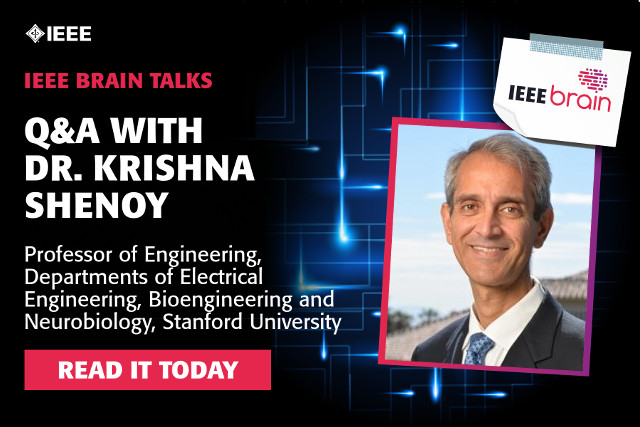Krishna V. Shenoy, PhD, is a Professor of Engineering with the Departments of Electrical Engineering and by courtesy, Bioengineering and Neurobiology at Stanford University. He is also a Howard Hughes Medical Institute Investigator. Prof. Shenoy holds a BS in Electrical and Computer Engineering from UC Irvine, a PhD in Electrical Engineering and Computer Science from MIT, and was a postdoctoral fellow in Neurobiology at Caltech. Prof. Shenoy directs the Stanford Neural Prosthetic Systems Lab (basic neuroscience and engineering) and co-directs the Stanford Neural Prosthetics Translational Laboratory (clinical trials), which aim to help restore lost motor function to people with paralysis.
You referenced Christopher Reeve in a recent presentation. Is the work you are pursuing something that he would have benefited from?
Krishna Shenoy: Yes. In fact, Christopher Reeve started a foundation which was supportive of our work for many years and which continues to really challenge the field to move forward in finding ways to help people who have lost motor function, potentially curing it if possible. The idea would be to progressively help people, much like the goals Christopher Reeve sought when he was alive, to first of all enable communication, then progress towards increased motor function of the limbs, and potentially even achieving the ability to walk again.
What brought you to this work? What drew you into neuroscience? Was this something you always wanted to do?
Krishna Shenoy: My initial training is in electrical engineering, yet I was intrigued by how the brain computes, maybe not unlike a computer, and that was an initial thing that sparked my interest. The key reason was to try to find ways to bring science and engineering together in order to help people. We are really working on projects that are far reaching and that can provide new therapies and new treatments that currently don’t exist, bringing many options and benefits for physicians, patients, and loved ones.
What’s the biggest breakthrough you see on the horizon?
Krishna Shenoy: I think a true breakthrough would be the ability to repair the natural nervous system, where a spinal cord injury would be treatable by having nerve fibers or so-called axons or fibers actually reconnect. That’s not generally considered to be possible, at least currently, but it would be wonderful if that were the case. I think one breakthrough that people believe possible in the coming 5 to 10 years is to be able to listen in on the activity of huge numbers of individual cells in the brain called neurons. The reason being that we have roughly 100 billion neurons in the brain and we’re currently listening to only about 100 of them. That’s sort of like listening to only a few people in an entire football stadium. If we could hear more of that conversation in the crackling of these cells in the brain, we could better understand what is going on in the brain, interpret those signals better, and perhaps even write “missing” information into the brain. For example, with arm movement, when you reach out and pick up a cup of coffee, you could feel the texture of the cup and other types of sensory information being written back into the brain. But if we think more broadly, beyond just paralysis, it could help with artificial vision systems, even more advanced hearing and auditory systems, and really get us to the point that we can think about treating a wide range of neurological diseases and injuries beyond just sensory motor type issues.
What kind of technological challenges do you have to overcome to get to that point?
Krishna Shenoy: The fundamental challenge is that you are inserting something into the body, and this is, of course, something we’re quite comfortable as a society doing with cardiac pacemakers or a variety of other systems. Yet, in this case, one very important aspect is neuroethics—determining if something is okay to do and being guided in a principled fashion. But speaking scientifically, it’s also how to keep the immune system or the other processes of the body from reacting to an implanted system and avoiding creating some sort of a scar tissue that could impair brain function.
It sounds as though material science plays a role in your work, as well.
Krishna Shenoy: Absolutely. I think that the more we learn about how to make structures that are very small on the size of fractions of a neuron, we will discover how to make them very flexible so that they can move with the brain. If you put in a fairly large and flexible electrode and then the brain moves around as it normally does as we walk around, or even breathe, it’ll constantly remind the immune system and the brain that there’s an inserted foreign object. However, if it’s made more neutral, flexible, and small, there will be less perturbance. Therefore, our colleagues in material science and engineering, as well as mechanical engineering and microelectronics, are critical to achieving this. It is a very interdisciplinary field that brings people together from all sorts of backgrounds ranging all the way through to clinicians, too.
For students who might be interested in continuing your work or getting into this line of work, do you have any suggestions, any advice, courses of study?
Krishna Shenoy: Follow your heart. There are so many entry paths to do wonderful work in this general area that it’s best to do what you love. In doing so, rest assured that you’ll be able to contribute. There’s no one area that’s more important than another. You might enjoy signal processing, fabrication or materials, but you will be working in a wonderful and impactful field. That said, recommendations one might be tempted to give today probably won’t be the same ones 10 or even 5 years from now. With that in mind, it’s important to pursue a sort of constant North Star towards what you personally find interesting.



